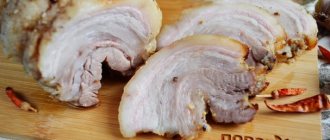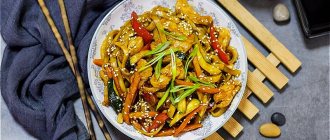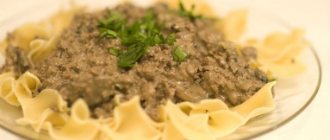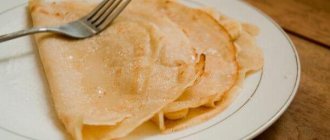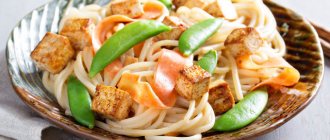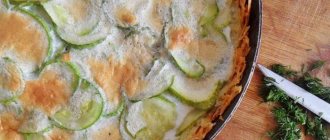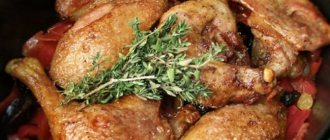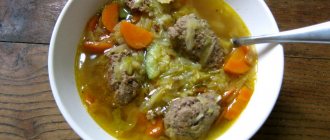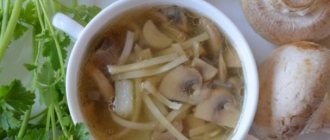Dungan noodles are a type of lagman. And therefore, our article will delight all lovers of Central Asian cuisine. But lagman was born in China. And since the Celestial Empire has a huge territory, it is not surprising that the basic recipe changed depending on the region. The Dungans are a people who in the modern world are divided by state cordons. About ten million people of this ethnic group still live in the People's Republic of China. The rest became citizens of Kyrgyzstan, Uzbekistan and Kazakhstan. But, despite the borders dividing the Dungans, they maintain common cultural traditions, including culinary ones. In this article we will give a recipe for their variation of lagman. This dish, regardless of whether it is a Chinese, Uzbek or Kyrgyz tradition, consists of two main components: noodles, which must certainly be prepared by hand, and vajji - everything else.
Some features of the Dungan lagman
At first glance, the dish looks like a mixture of the first and second. Lagman can be described as a very thick soup. The vaja and noodles for it are prepared separately. These two components are found only in a portioned plate, or rather, in kasas - deep bowls where lagman is placed in layers. First they put the waju, then the noodles, then place the gravy and sprinkle fresh herbs on top - cilantro and dill. Now a few words about the main difference between the Dungan lagman. The vermicelli in this dish is special. Dungan noodles are prepared by stretching the dough. Not only factory-made pasta (even Italian tagliatelle of the highest quality) will completely change the correct taste - the cut or rolled homemade noodles we are used to will also only imitate lagman in appearance. Therefore, we will devote the article to only one issue. Namely, the recipe for making these pulled pasta. But we will also pay attention to the vaj.
Nutritional and energy value:
| Ready meals | |||
| kcal 1528.8 kcal | proteins 47 g | fat 21.2 g | carbohydrates 188.6 g |
| Portions | |||
| kcal 382.2 kcal | proteins 11.8 g | fat 5.3 g | carbohydrates 47.2 g |
| 100 g dish | |||
| kcal 134.1 kcal | proteins 4.1 g | fat 1.9 g | carbohydrates 16.5 g |
How to cook Dungan noodles at home
Asian lagman requires some exotic products: jusai (a plant similar to a green onion with a distinct garlicky taste and smell), choho (a set of spices), daikon radish, fat tail fat, cottonseed oil for gravy. All these components can, in principle, be replaced with more familiar products. But Dungan noodles are prepared simply at home and without any Asian ingredients. To knead the dough, we only need a kilogram of white wheat flour, two eggs, half a teaspoon each of salt and soda. And it's all. The Dungans living in southern Kazakhstan do not use eggs, but add water to the dough. Here we present a recipe that is popular in Uzbekistan and Kyrgyzstan.
Ingredients
- for the dough:
- 1 kg. flour,
- 2 eggs,
- 1 tsp salt
- per solution 1/2 tsp. salt and 1/2 tsp. soda),
- 200 g cottonseed oil for lubrication (preferably, if not, vegetable oil can be used)
- for gravy:
- 500 g lamb,
- 100 gr. fat tail (lamb)
- 200 ml. cottonseed oil (or vegetable oil)
- 2 -3 potatoes,
- 1 turnip (more),
- 2 carrots,
- 3-4 onions
- 6 -7 cloves of garlic (optional)
- salt
- black pepper, red pepper (paprika), cumin
- greens (cilantro)
Dough base
Sift the flour into a deep bowl. Let's leave it a little for sprinkling the table while rolling out. Add eggs and a glass of water. Stir and let stand for an hour, covered with a damp cloth. While our Dungan noodles are being prepared in this energy-saving way, the lagman recipe invites us to do vaj. Cut the lamb and tail fat into pieces. We chop all the vegetables separately. If we use cottonseed oil, it must be calcined. Pour it into the cauldron and wait for smoke to appear. Throw a whole peeled onion into the boiling oil. When it absorbs the bitterness, take it out and throw it away. We fry lard. Fish it out onto a plate and sprinkle it with salt. Now you can add meat to the oil. Fry until golden brown. Then reduce the heat to low and leave the contents of the cauldron to simmer under the lid.
Spaghetti recipe
- spaghetti-0.5 kg
- beef 0.5 kg
- 2 medium potatoes,
- hot green and red peppers,
- cabbage,
- carrot,
- onion,
- garlic,
- tomatoes (can be replaced with tomato paste),
- radish (can be replaced with radish),
- bell peppers,
- greens and preferably garlic grass jusai (can be replaced with green garlic in feathers)
- olive oil
Cooking
- Cook spaghetti in salted water with olive oil. 0.5 kg beef, cut into 2x2 cm cubes.
- put a cauldron on the fire and pour about half a glass of oil into it and heat it until blue smoke comes out. cut the onion into small pieces and fry it until golden brown in boiling oil.
- Next, add the chopped meat and let it fry in boiling oil for 5-6 minutes. After this, add 2 cups of boiling water to the cauldron.
- Close the lid and let it simmer for a while over medium heat until the water partially evaporates. I want to warn you right away - there will be a lot of garlic and pepper.
- Finely chop a hot green pepper and 2-3 cloves of garlic. And add it to the cauldron with the meat and mix thoroughly.
- Now you need to salt the meat for the first time (approximately 1 teaspoon of salt)
- Add the chopped tomatoes. And let it boil for 5 minutes. And then add the vegetables. Let it boil for 5-6 minutes.
- Next, add the potatoes and fill the whole thing with hot water so that the water covers the vegetables by about 2 fingers.
- Mix everything well, let the water boil, add salt and pepper to taste, you can add vegetable seasoning like Vegeta.
- Reduce heat to low, cover with lid, and leave for 30 minutes. While Lagman comes to mind, you need to prepare hot seasoning - 2 hot peppers and garlic. Finely chop everything.
- Place a small saucepan on the fire and pour in a quarter cup of olive oil, let it boil, then add 1 tablespoon of dry chili pepper and add pepper and garlic.
- Add a little salt, stir constantly for about a minute and a half and remove from the heat. The result is Adjika. Our lagman is already ready - turn off the heat, we only need the final touch - fresh herbs and jusai, as well as garlic
- All this must be carefully chopped with a knife and added to the finished lagman, cover with a lid and wait 5 minutes. Lagman is eaten from deep plates or large bowls
- put the prepared noodles on a plate, add a ladle of gravy, top with one teaspoon of Adjika and cover everything with freshly chopped herbs and enjoy….
Knead the dough
While the meat is stewing in this way, we continue to describe how to prepare Dungan noodles. Pour a glass of warm water. Dissolve half a teaspoon of salt and soda. Knead the dough base that has rested for an hour and moisten it with prepared water. This is done so that it becomes viscous and viscous. Kazakh housewives recommend leaving the bun under a napkin for another ten minutes. During this time, add onion, garlic, soy sauce and salt to the meat. Knead the rested dough again and divide it into pieces so as to roll them into balls weighing thirty grams each (the size of a large walnut). Form each ball into a sausage with your fingers, stretching them out until they are the thickness of a pencil. Grease the surface with vegetable oil to prevent the noodles from sticking together. Let's leave it for another twenty minutes. During this time we will deal with vajya. Add carrots, bell peppers, celery, and radishes to the meat. Mix. We fry the cabbage. Finally, add potatoes and tomatoes to the cauldron.
Calorie content of foods possible in the dish
- Jacket potatoes – 74 kcal/100g
- Fried potatoes – 192 kcal/100g
- Ripe potatoes – 80 kcal/100g
- Boiled potatoes – 82 kcal/100g
- Baked potatoes – 70 kcal/100g
- Mashed potatoes – 380 kcal/100g
- Green cabbage – 46 kcal/100g
- Fresh frozen green cabbage in packaging – 45 kcal/100g
- Tomatoes – 23 kcal/100g
- Sweet pepper – 27 kcal/100g
- Carrots – 33 kcal/100g
- Boiled carrots – 25 kcal/100g
- Dried carrots – 275 kcal/100g
- Garlic – 143 kcal/100g
- Bay leaf – 313 kcal/100g
- Ground black pepper – 255 kcal/100g
- Radish – 35 kcal/100g
- Vegetable oil – 873 kcal/100g
- Hot chilli pepper – 40 kcal/100g
- Salt – 0 kcal/100g
- Water – 0 kcal/100g
- Onions – 41 kcal/100g
- Wheat flour – 325 kcal/100g
- Greens – 41 kcal/100g
- Fresh frozen soup greens in packaging – 41 kcal/100g
Calorie content of foods: Wheat flour, Water, Any meat, Onions, Vegetable oil, Potatoes, Tomatoes, Radish, Carrots, Cabbage, Bell pepper, Garlic, Ground black pepper, Bay leaf, Hot pepper, Salt, Herbs
Dungan noodles: preparation
The most crucial moment is coming. Our dough is stretchable. It is very flexible and similar to chewing gum. We take one flagellum with both hands by both ends. Shake it so that the middle of the stick hits the table. Now we connect the ends. We take them with one hand and the middle of the noodles with the other. Shake the now long tourniquet again. So we pull out each tourniquet. Don't forget that we have a cauldron of wadja on the fire. Add water there so that the vegetables and meat are not fried, but stewed. But there should be little liquid. Water should only half cover the meat and vegetables. Let's do the test again. We need to ensure that each pasta reaches a length of at least one meter. Let's leave it to air on the table.
Cooking pasta
Dungan noodles should turn out long and thin. As we remember, it is found with the second component of lagman - vaj - only in a plate. It is cooked separately. Place a pan of water on the fire. When it boils, add some salt. Place Dungan noodles in the pan. The dough for it has the disadvantage that it can quickly boil over. Therefore you need to be careful. Stir with a wooden spoon and wait until the dough rises. After this point, cook for another three to four minutes. Drain the contents of the pan into a colander. To completely stop the heat treatment process with the remaining internal heat, pour cold water over the noodles. And so that it does not stick together in a colander into one lump, we season it with vegetable oil. Let's not forget to mix.
The final phase of cooking lagman
Then preparing lagman comes down to pouring water at room temperature over the fried meat and vegetables so that the water completely covers it. Lagman will be tastier and more filling if you use meat broth instead of water. It is better to use beef broth with a bone for this purpose. If he is in the house at this time. Then the future lagman is seasoned with spices to taste. But you can add salt at the end. For red meat lagman (beef, lamb), the stewing time will be at least 40-45 minutes. While stewing meat and vegetables, boil the noodles separately. Ideally, it is better to use homemade noodles. This is how it is done in the East. For 250 g of such noodles you will need 2 cups of white flour and 2 chicken eggs. The recipe is simple, knead these products into a dough, adding ½ teaspoon of salt. Roll out the dough, cut into strips, and dry for at least an hour. But if the recipe is not so strict, then you can use a long straw purchased at a nearby store at home. Before boiling, the water in which the noodles will be boiled should be lightly salted. And only then dip noodles into it, or, at worst, vermicelli.
It is better to boil the noodles until half cooked. Italians use the term “aldente” in such cases. Translated into Russian “by the tooth”. That is, the finished noodles should not be raw, but at the same time not be overcooked. It will still have to be mixed with meat stewed with vegetables. And there the noodles, as they say, “will arrive” after mixing. It is especially recommended not to lightly cook the noodles if the family will eat lagman the next day.
Lagman is served on separate portioned plates. Place the meat on the dish. In this case, it should be thickly poured with the resulting sauce. After the meat, lay out the vegetables, and then the noodles. The recipe stipulates that the dish must be decorated with fresh herbs. It is best if it is dill, parsley or cilantro. The quantities in this recipe are for servings for three people. Despite the small amount of each ingredient used, dinner with such a hot dish will be satisfying. Raw vegetables would look quite appropriate along with lagman on the table: tomatoes, sweet peppers, fresh cucumbers cut into slices. You can also make a salad from these same vegetables, as a culinary antithesis to hot and spicy lagman.
Chuzma lagman is ready. Bon appetit!
( 3 votes, rating: 2.67 out of 5)
Serve lagman
Let's finish the vaja. We taste, add bay leaves, spices, and add salt if necessary. We should get a very thick soup or, if you prefer, meat and vegetables with a lot of sauce. Dungan noodles should be warm before serving. It can be heated in the microwave or in the oven. We scoop out thick meat and vegetables from the cauldron with vajya. Place in a deep plate. Place Dungan noodles on top. Pour in the liquid (sauce). Sprinkle the dish with fresh cilantro and dill on top. In some regions, vinegar is added to the lagman. Separately, roasted tail fat and bread are placed on the table in a bowl.
Cooking step by step
The first step is to prepare the vegetables for stewing. They are washed and cut. The onion is finely chopped. You should do the same with garlic. For speed, carrots are grated. In some cases, it is also finely chopped into strips with a knife. Radishes are cut in the same way as onions. Jusai shreds as finely as onions and carrots. This completes the preparatory vegetable stage. Next, the recipe involves processing the meat. It is advisable to use young meat, without fat and tendons. An ideal recipe when using young lamb or veal loin. The speed of preparation of the dish only makes its recipe more attractive in our dynamic age. Therefore, it is best to cut the meat into cubes weighing 20-25 g.
The preparation of such lagman begins with separate frying of the meat until golden brown. It is better to carry out all operations in a cast iron, so the dish will not burn. For this operation you will have to spend 10-15 and 3 tablespoons of vegetable oil. After the crust has formed, onions are first added to the meat. Fry the meat with the onion until the onion turns amber. Next, add carrots, jusai, and paprika. The last vegetable to be added is the radish so that it doesn’t get overcooked. Add tomato paste and mix everything, sprinkling with teho. Turn down the heat and fry everything for no more than 10 minutes. A lot depends on the quality of the meat. You will have to tinker with old meat for all of 20 minutes.
